Hunters and gatherers used to study animal prints to find survival food.
You may not need to do that anymore but might want to know about it and would possibly enjoy identifying the tracks of critters scampering or sneaking through your backyard.
We start by giving you ways to recognize the common gray squirrel, chipmunk, rabbit, raccoon, striped skunk, and move on to the more surprising from there.
Gray Squirrels
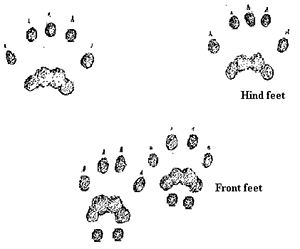 They are common in areas where oaks grow. They love acorns and also eat insects, larvae, vegetation, fungi, berries, and nuts.
They are common in areas where oaks grow. They love acorns and also eat insects, larvae, vegetation, fungi, berries, and nuts.
Squirrels produce a hoarse, barking noise and reprimand intruders with a chirring sound. Squirrels use bark, sticks, and leaves to build their nests high up in trees and shelter in tree hollows in winter. Fall is the best time to see them.
They have four front and five hind toes. The large hind feet land in front of the smaller front feet when they hop.
Chipmunk
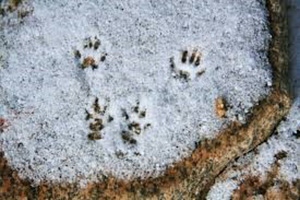 Chipmunk tracks are a rare find. Chipmunks favor shrubby and rocky areas and deciduous forests that provide cover. We often see them in backyards and parks.
Chipmunk tracks are a rare find. Chipmunks favor shrubby and rocky areas and deciduous forests that provide cover. We often see them in backyards and parks.
They make nests in bushes or logs or create burrows that include an underground tunnel structure.
They are active during the day – hopping, leaping, and leaving a galloping trail pattern.
Related: How To Deal With Unusual Garden Invaders
Chipmunk imprints look much like those of mice. They have four toes on their front and five on their larger back feet.
Rabbits
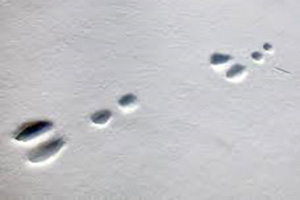 They are timid and prefer areas they know.
They are timid and prefer areas they know.
Their four footprints form a capital letter J when they move at an average speed. Their larger hind feet land side by side to shape the top bar. The smaller front prints lie behind to mold the base of the J.
Rabbits place their front feet on the ground first when they move and then swing their back legs forward to land up ahead of the front footprints. The front feet are typically a little to one side behind the back feet.
Striped Skunks
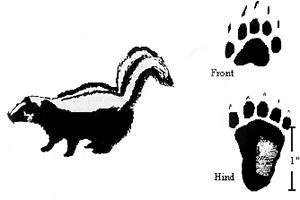 Striped skunks live in brush areas, grasslands, and marshes. They eat berries, grasshoppers, and small animals, worms, eggs, and poultry, to name a few.
Striped skunks live in brush areas, grasslands, and marshes. They eat berries, grasshoppers, and small animals, worms, eggs, and poultry, to name a few.
Their tracks look like tiny bear paws, with claws on the front feet look like dots that show well ahead of the five toes.
Skunks use their long front claws to dig up insects and roots. The large heel pads on the hind feet – that also have five toes – are long and rectangular.
Related: The Easy and Practical DIY Snares to Catch Small Wild Game
Raccoon
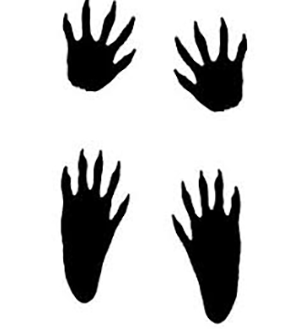 Their footprints look like human hands and measure two to three inches across.
Their footprints look like human hands and measure two to three inches across.
The front foot has five long digits that resemble four fingers and a thumb. The back foot has five long toes with a larger palm pad, and the thumb points forward. The back foot comes to rest next to the opposite front foot when the animal takes a step.
You will see a front foot and the opposite side’s rear foot next to each other in the snow when it walks.
Deers
Deer leave a well-defined print.
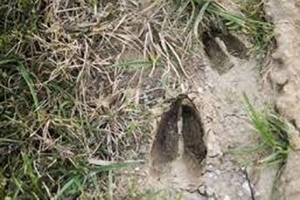 You may have mule deer, black-tailed deer, elk, moose, or white-tailed deer in your suburban town, depending on where you live.
You may have mule deer, black-tailed deer, elk, moose, or white-tailed deer in your suburban town, depending on where you live.
Deer have four toes, but only the first two large hooves usually show. You may see the smaller dewclaws if they jump, run, or walk in a deep substrate.
Keep an eye out for their upside-down heart-shaped tracks that display visibly in grass, mud, sand, and moss. The imprint has convex sides with the hoof tips located towards the inside.
Related: The Ultimate Wild Game Meat Processing Charts for Preppers
Coyote
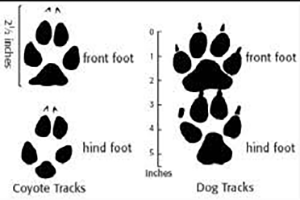 The tracks are not the same as dog tracks.
The tracks are not the same as dog tracks.
You may not see a coyote in the wild, but it would be thrilling to be able to identify its imprints.
The rear paws and pads are also smaller than the forepaws and cushions.
Coyote tracks have claws that do not show on hard ground. Their footprints are oval-shaped or oblong. Their nails are not as prominent, and the pads are more compact than those of dogs.
Gray or Timberwolves
They are the mightiest canines in North America and live in large parts of Canada, Alaska, the upper peninsula of Michigan, Montana, North Dakota, Idaho, Oregon, Wyoming, Wisconsin, Washington, and Minnesota.
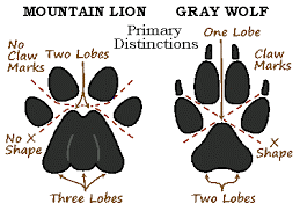
They can be silvery, black, white, or gray. Wolves can journey for over 250 miles.
They have four toes on each foot, and you can see their claw marks. You may have a problem distinguishing their footprints from those of a large dog but will usually find them far away from human territory.
Their imprints may measure between 4¼ to 4¾ inches long, and their stride can be 26 to 30 inches. The expanse between groups of prints can be six to eight feet if a wolf runs at full speed.
Mountain Lions or Cougars
They roam where the deer are. Their favorite habitat is mountainous terrain and rocky or steep canyons – from sea level to 10,000-foot altitudes, coastal forests, and deserts in North-Western Canada to Patagonia in South America.
Related: The Map That Shows You The Edible Trees In Your Neighborhood
You can draw a C between a cat’s pads and an X in a canine track without colliding with a toe.
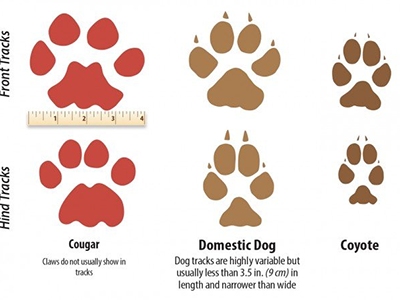 All cats generally have a leading toe, three lobes at the base of the sole, teardrop-shaped toes, and we only see claw marks when the cougar builds up speed or needs extra traction. Their tracks are about 3 to 3½ inches wide.
All cats generally have a leading toe, three lobes at the base of the sole, teardrop-shaped toes, and we only see claw marks when the cougar builds up speed or needs extra traction. Their tracks are about 3 to 3½ inches wide.
And Finally
We conclude with the problem that hunters tracking black bears often kill grizzlies by mistake. It is against the law to kill, harass, or kill grizzly bears unless you need to defend yourself or others. The Endangered Species Act protects them.
We need to know the differences between the species in case we stumble upon a bear.
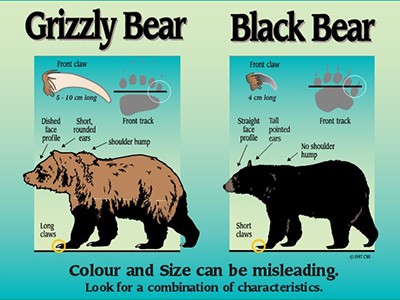 A black bear track is more rounded than a grizzly’s, meaning a straight edge will intersect the toe on the side if you hold it across the front foot. Grizzly tracks are squarer, and a horizontal edge in front of the pad and behind the toes will not cross the smallest toe on the other side of the front foot.
A black bear track is more rounded than a grizzly’s, meaning a straight edge will intersect the toe on the side if you hold it across the front foot. Grizzly tracks are squarer, and a horizontal edge in front of the pad and behind the toes will not cross the smallest toe on the other side of the front foot.
The Grizzly has long, gently curved, two to four-inch claws on its front paws. The nails can be a light color.
Black bear claws have dark, sharply curved nails that are frequently much shorter than two inches. Both species may range in color, and size is also not a classification indicator.
The Grizzly’s strong shoulder muscles look like a hump from the side. The middle or rear of the black bear’s back is its highest point when standing, contingent upon your sightline.
We wish all preppers and survivalists happy animal tracking, whether in your backyard or the wide outdoors.
Enjoy learning about animal movement and behavior, along with studying how modern societal development can either hamper or benefit our wildlife.
You may also like:
 How To Identify And Prepare Nutritious Mallows
How To Identify And Prepare Nutritious Mallows
Backyard Projects That Might Get You Arrested (Video)
5 Traps to Catch Animals While You Sleep
DIY Seed Tapes With Toilet Paper
Why Now More Than Ever You Should Prepare For The Upcoming EMP

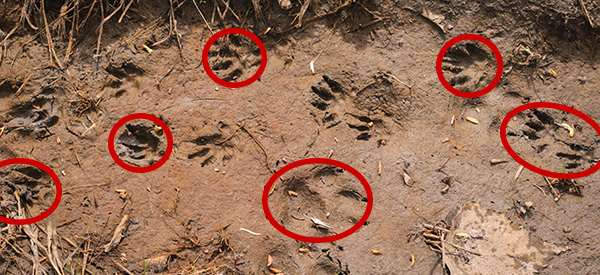











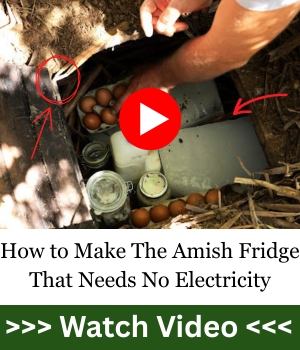








I like this artical.
Got good at tracking when I was a kid. Still tracking all things even today.
Poop is a way to track, also. Tell a lot with poop. How fresh or how old by the color and by feel and smell. Can even tell if that animal is healthy or sick. At times you can tell what they ate also.
I did not see any fowl tracks in here but that okay.
Well done article.
Most can learn a lot on this article.
Position of some tracks will help ID the gender. Tracking deer or elk, a normal step will be consistent and the back prints will somewhat over lap the front. Bucks/bulls will have a larger chest, does/cows a wider hind set. So the impressions can tell a story. Younger animals harder to tell.
Took the family camping last weekend. Tons of deer, raccoon, and squirrel tracks.
Forgot the most common game animal in the U.S. — the feral pig. In an EOTW situation, in a great many states the feral pig will be the most hunted animal. In your garden plot they will do the most damage. A sounder of pigs in your home garden will destroy it in one night. Between eating above ground vegetables and rooting up in-earth grown vegetables and pooping on everything else, they can totally destroy your year’s worth of crops. Even Red in SoAz is not safe from javelina which are a smaller version but just as hungry as their larger cousins.
A relative lives in Sedona and has outside security cameras and they record regular nightly visits from javelina. Any vegetables they might plant would jus draw bigger crowds of nightly visits.
On a lesser note, don’t forget good ole Peter Possum. Aside from rats, possum are probably the most frequent urban critter you will find in your backyard. You can find them in Mickey D’s trash containers, behind the grocery store in the trash containers, restaurant row’s trash containers — anyplace where garbage is not tightly contained. Leave the lids open on dumpsters with garbage and pretty soon along about 0200 it will be crawling with possum.
You might start saving possum recipes as they are also among the easiest to catch. Make sure they are really dead before attempting to pick them up. They will “play possum” until you pick them up and then you will find they have pointy sharp teeth and given when they dine on, probably loaded with all sorts of nasty bacteria. On the plus side, they are mobile garbage disposal units, so they do serve a useful purpose and best case, your watch dog will enjoy the meat when you run out of dog food. Just make sure you cook it thoroughly before turning Fido loose on it.
A simple search: What do possum tracks look like should reveal numerous videos and article complete with pictures of any animal you might care to identify by tracks.
I know a guy who was in charge of wind machines for citrus. They are only used in the winter when it freezes, the rest of the year unused. Rats then make nests in them so they need to be cleaned out before starting up as well as repair any damage. But the ones that have an opossum living it were rat free and opossums never caused any problems with the machines. They were a very valuable asset for him to have.
After the end of the world, unless one can reconfigure a wind machine to generate electricity from naturally occurring winds, they will be useless. If possum and rats like to live in the wind machines, that would be a good place to set your traps. While you might draw the line at eating rat and possum, Fido will certainly relish both as food.
LCC
Me personally but I’d have to be starving before I ate a opossum. I wouldn’t want to take the chance it was not well.
I know a woman who rehabbed wild animals. Someone I think with the state wildlife department brought her an injured opossum. Unbeknownst to anyone it had parvovirus. The woman got it too from caring for the diseased animal. I’m not positive but I think once you have it it is forever. The symptoms can be treated but it cannot be cured according to the woman who got it. It was very painful for her and almost completely debilitating.
Also I’ve heard too many stories about them being scavengers and eating anything dead they could find.
I’ll have to pass on the opossums. ?
Opossums are also good for tick control.
I saw one play dead once, when my cousin’s dog thought she could bring it up to the house and show my cousin her quarry. It was at night, and the dog had been let out to do her business before everyone turned in.
The possum lay there motionless, and we gazed at it courtesy of the outside porch light as we were inside discussing what to do. The dog had been back in the house for a few minutes, when the possum got up and trundled off into the night.
LCC: Now, javelina are just shy woodlands critters that have the same evil temper of razorbacks. I like javelina! Tasty 🙂 ‘Tis the season they attack dogs, dog owners, and anything predator-like. If you do not want them in the garden, spicy winter radishes make them shriek in pain (sinuses) as will moringa root. Funy, tho, is they’ll eat cactus. Next night, when they pass all those thorns their eyes get as large as saucers. Right now, babies are being born, so mind them. They’re only shy during hunting season. niio
Thank you very much for this informative article! I recently purchased a little card game as a gift called “Match a Track” where you match 25 animals with their respective paw prints. Now I’m going to use the information in this article to expand that game and make some of my own cards to add to the box! The recipient will likely find some of these prints in their yard before many in the original box! Not too many koalas, elephants and hyenas running around here in the wild on Long Island!
Just to support my posit, I went on line and the first page that came up after I typed in “what do possum tracks look like” contained twelve entries together with one entry that featured several sets of tracks, even comparing them to a human shoe (size unknown).
God article to print and save! niio
Yep God would be really proud if saved this article,,, lol
Who in the wide wide world of sports would mistake a grizzly for a black bear?
Knowing what an animal eats and what grows where and when in your locality is more useful for hunting, but knowing the tracks of the animals that live around you is knowing old friends are around.
If you live where there are feral hogs hunting varmints is a waste of time. Squirrels and rabbits won’t keep your family alive and after a few weeks you will have wiped them out. An average Texas feral hog dresses out to 75 pounds of good tasting high quality lean meat. We shoot ’em from blinds, run ’em with dogs, most efficient is live trapping them, but the State says they reproduce so fast we’d have to kill 2/3 of the population every year just to keep the population stable, right now we only get about 1/3 of the critters. The U.S. cattle industry started after the War of Northern Aggression when Texans on horseback drove millions of feral cattle to the rail heads up north. Haha, after SHTF, all us Texas Cowboys be herding pigs!
Jed Clampett and Granny made possum stew all the time.
Mailpouch – Many thanks! Just placed an order for the book! Sure to come in handy when I venture out of the city!
City Chick,
You’re welcome. I hope it helps and you enjoy it.
I’ve had my copy for decades…lol
I bought it when I first started hunting. I knew nothing about hunting or tracking being raised in town and my dad didn’t hunt.
For me the book was very helpful. ?
If a person is interested in a hard copy book there is an excellent book “How to Track and Find Game” by Clyde Ormond
Mailpouch: got it! Be fun to read, I think. We were avid hunters, and my last dog, a dachshund, taught himself to hunt. My youngest’s friend lost every tree in the orchard to rabbit one winter (I think it was like 20,000 dollars worth). They were trying to knock off rabbits, but one shot and al the rabbits disappeared. They took bubba der shrek out to get some exercise on the farm. He had been cage raised, allowed out in a yard one hour a day, and then back to the cage. He got hot on the trail of a rabbit and by accident ran it out where they shot it. He stopped, stared, and then very slowly came to the babbit to see why it stopped running. then they shot another and he decided that yeah, man, this is what life is all about! They got about 27 rabbits that day with his help. He was so stuffed with the hearts and livers he didn’t eat for 3 days, then back to the hunt! niio
I didn’t find parvovirus transmitted to humans from opossum, but:
“There are many different types of diseases that are carried by opossums that can be transmitted to people, and those transmitted through urine and feces are often the most easy to catch, such as leptospirosis, which has flu like symptoms for most people, but can cause kidney damage, meningitis and even death in a small number of cases. Salmonella is a condition that is largely believed to be related to food poisoning, but can also be transmitted by opossums, and while it causes diarrhea for most people, the elderly and young children may find themselves at risk of more severe symptoms, with reactive arthritis one possible side effect”
http://wildliferemovalusa.com/opossum-diseases.html